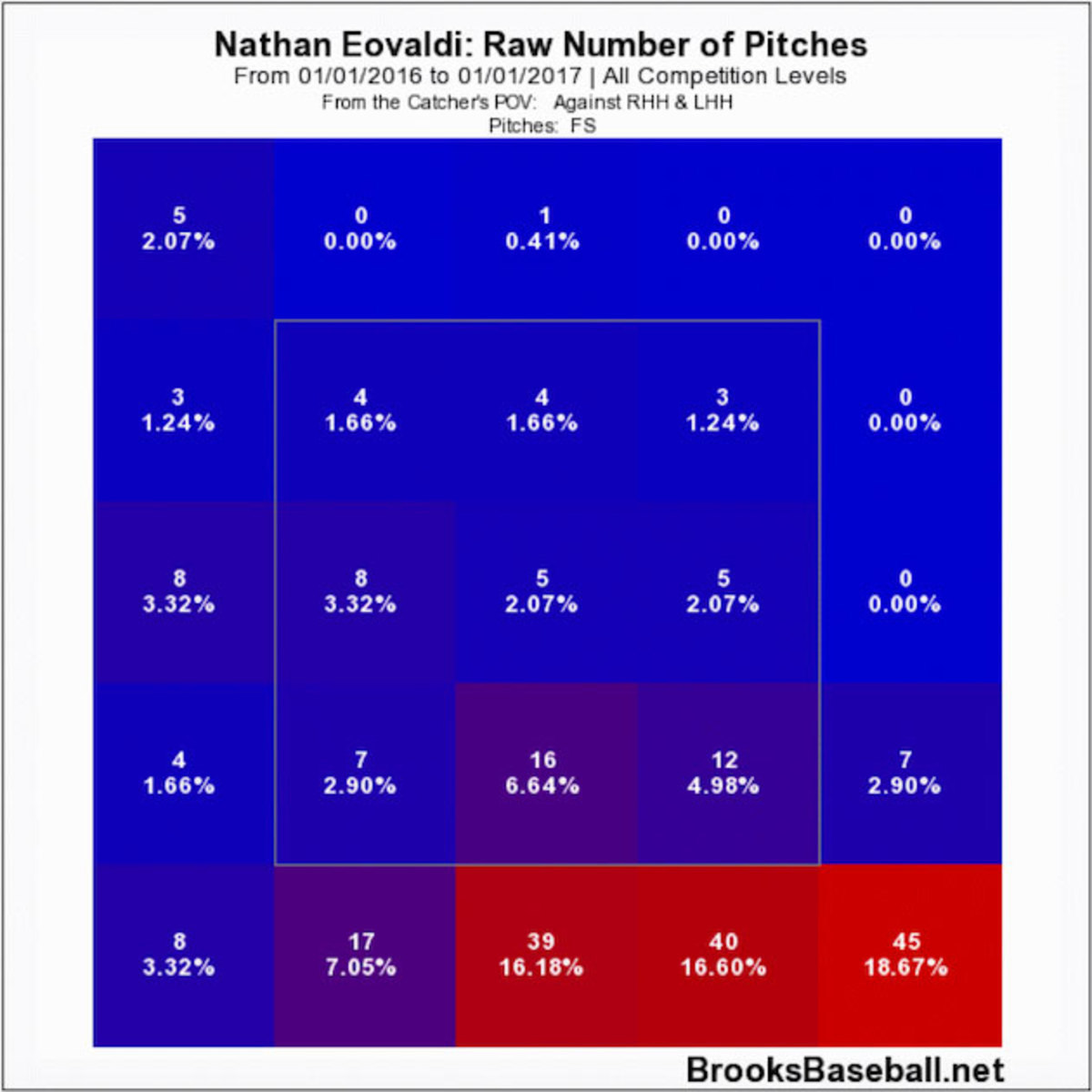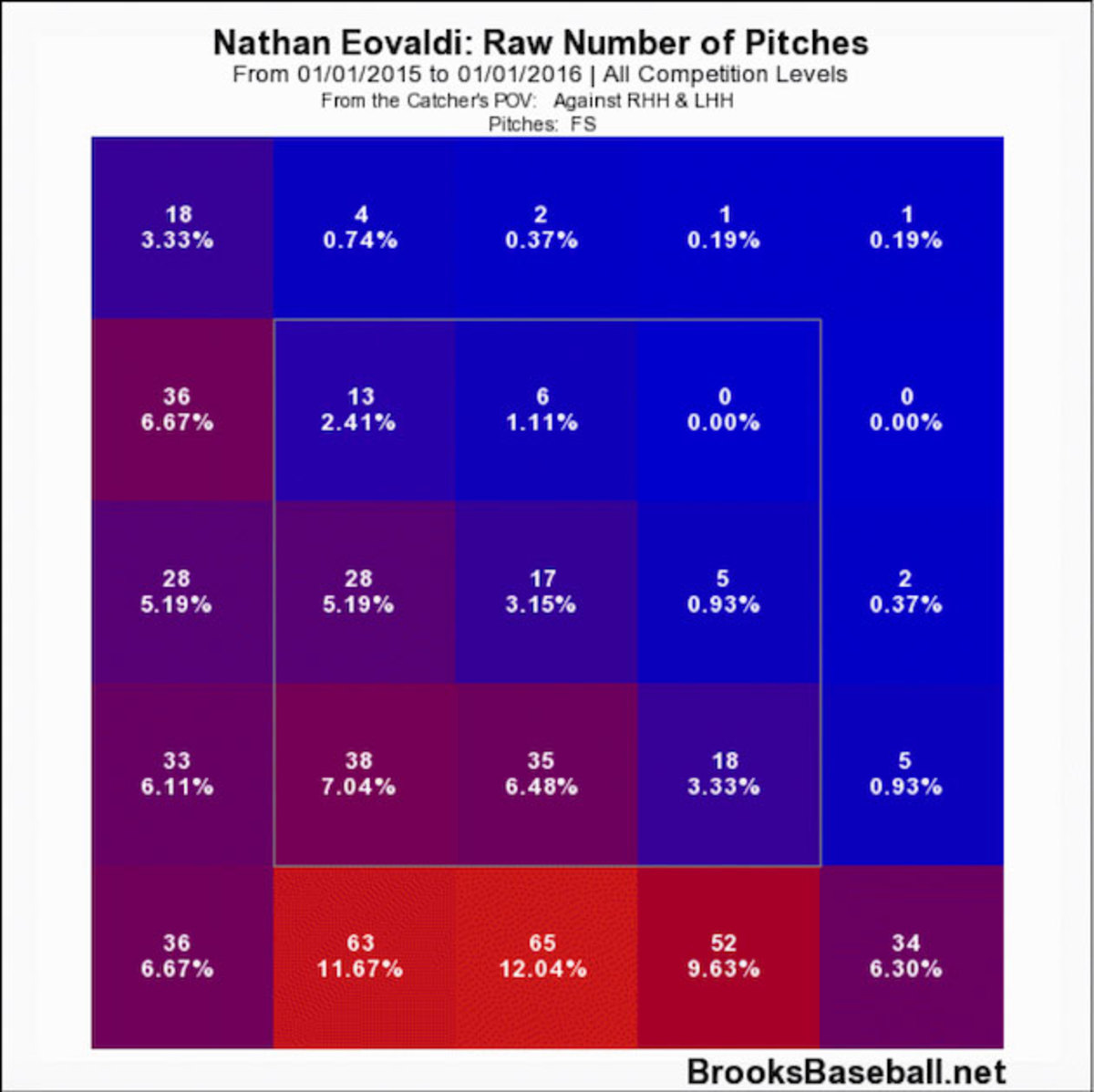Pitching Report: How one pitch made Nathan Eovaldi fantasy relevant

Nathan Eovaldi was a five-pitch pitcher over the first 46 starts of his career. In addition to an overpowering four-seam fastball, he had a changeup, slider, curve and, in his first two seasons, a sinker in his repertoire. Through those same 46 starts, Eovaldi also found success to be maddeningly elusive, especially for a player with his natural stuff. Entering 2015—his age-25 and fourth full season—it was clear he needed to change something.
Last season, Eovaldi eschewed the changeup that he rarely used, and with good reason. He threw it 269 times in his first four seasons, with hitters racking up a .444 batting average and .635 slugging percentage against the pitch. Addition by subtraction is great in theory, but Eovaldi wasn’t going to change his fortunes without an offspeed pitch that played off his fastball. As such, in 2015, he started throwing a split-finger fastball.
Fantasy baseball Waiver Wire: Jhonny Peralta a worthy pickup
Eovaldi threw his splitter 20.5% of the time in 2015, making it his third most-used pitch behind his fastball and slider. It also immediately became one of his most effective offerings. When it was the deciding pitch of an at-bat, hitters had a .204 batting average and .233 slugging percentage, and Eovaldi got a 17% whiff rate and 69.5% ground-ball rate with the pitch overall. Unsurprisingly, with the splitter joining an already strong fastball/slider combination, Eovaldi had the best year of his career in 2015: His ERA clocked in at 4.20, but he registered a 3.42 FIP and a career-best 18% strikeout rate. Those numbers don’t jump off the page, but they were the first steps in the right direction Eovaldi had taken in some time. It seems they may also have presaged, at the very least, a mini-breakout.
This season, Eovaldi has been a stabilizing force in the Yankees' rotation: Through 10 starts and 60 2/3 innings, he has a 3.71 ERA and 1.17 WHIP. What’s more, his strikeout rate has surged to 22.9%, and he has cut his walk rate to 6%. His ground-ball rate is up to 54.8%, and he has slashed more than five percentage points off his line-drive rate. Eovaldi is finding a new level of effectiveness this year, and he owes much of that to his splitter.
Before we get to the nitty-gritty on Eovaldi’s splitter this season, let’s take a look at its devastating effects.
The splitter is so deadly for Eovaldi because he can easily mimic the arm slot and speed he uses with his fastball, but it comes it at an average of 89.4 mph with sharp downward movement; his fastball blazes into the zone at 97.8. That’s a filthy pair of pitches. Then there’s the matter of his slider, which he can typically count on for a double-digit whiff rate.
Eovaldi is using his splitter more often this season, throwing it 25.3% of the time. That’s the second-highest usage rate he has had for any non-fastball, behind only his slider in 2014. If the pitch remains this effective, it’s likely it will surpass the 2014 slider to become his favorite out pitch in any individual season.
Is Leonys Martin’s improvement for real? Take a look at his swing
It’s not hard to understand why Eovaldi is throwing the slider even more in 2016 than he did a season ago. He has a 17.4% whiff rate with the pitch and the eighth-best whiff per swing ratio of all pitchers who have thrown at least 100 splitters this season. Eovaldi’s ground-ball rate with the splitter is 64.6%, and hitters have managed just a .187 batting average against the pitch. He has surrendered a .160 isolated slugging percentage on the splitter, but that owes to the frequency with which he throws it as much as anything. When you throw a specific pitch one-quarter of the time, you’re going to miss with it every now and again, and the splitter is a pitch that tends to really hurt a pitcher when it’s too hittable.
Eovaldi was already good at commanding the pitch last season, as his zone profile, courtesy of Brooks Baseball, displays.

A splitter absolutely needs to be down, preferably beneath the zone, to be effective. Low strikes create ground balls, and splitters that start in the zone but dip out of it create whiffs. Eovaldi was great with the pitch north and south, but he could have been finer east and west. Too many of his pitches were in the middle of the plate, which can get a pitcher in trouble if he misses with the pitch up. In addition, low strikes are great, but they’re not going to get whiffs as frequently as pitches that end up below a hitter’s knees, while still looking tempting. Eovaldi is commanding the pitch better this season, evidenced by his 2016 splitter zone profile.

If you could reverse engineer a heat map for splitters, this is what you’d come up with, and then you’d figure out how to make a pitcher duplicate it. Eovaldi’s command with the splitter is sure to keep his whiff and ground-ball rates high. Couple that with one of the league’s hardest fastballs and a better-than-average slider, and his performance over the first seven weeks of the season starts to look a lot like a new normal. That may not make him much more than a top-40 fantasy starter, but it does push him to a level he has yet to reach in his career, despite the obvious potential to do so: a yearlong fantasy-relevant starter.
Pitchers to Watch This Week
Clayton Kershaw, Dodgers
In reality, Kershaw is always a pitcher to watch. We’re not telling you anything you don’t know by saying you should keep an eye on him when he takes the mound for his only start this week. But what makes this week one in which you should watch him, even more than usual? Well, Kershaw will take on the Braves on Friday. If you were ever going to predict a perfect game in advance, the best pitcher—by far—in the game against an offense that might go down as historically terrible would be the time to do it. At the very least, we should be in for some vintage Kershaw this weekend, and there’s never anything wrong with that.
Drew Smyly, Rays
Smyly has struggled in three of his last four trips to the mound, and even in his one good start over that timeframe, he went just five innings. He surrendered 14 runs on 23 hits in 17 1/3 frames in the bad ones, and, just as importantly from a fantasy perspective, struck out just 14 batters. Smyly’s best fantasy attribute is his ability to miss bats, but that has abandoned him over the last month or so. He still has more than a strikeout per inning on the season, but most of the heavy lifting came in April. Smyly’s average fastball velocity has dipped by start, beginning at 91–92 mph and falling to just over 90 in his last four trips to the mound. Fantasy owners should have their eye on that when he takes the ball against the Royals on Tuesday.
Lance McCullers, Astros
McCullers is coming off his best start of the season, striking out 10 batters in five innings in a win over the Orioles, and after missing the first five weeks of the season due to a shoulder injury, he seems to be rounding into form. The young righty surged to prominence last season thanks to his strikeout upside, and we’ve seen it in two of his three starts this year. Even as he was shaking off the rust in his second outing of the year, he fanned seven in six frames in a loss to the Rangers. Let’s also appreciate the degree of difficulty McCullers has already had this year—he's faced the Red Sox, Rangers and Orioles, who rank first, 14th and seventh, respectively, in weighted on-base average. He’ll draw another tough assignment when he toes the rubber against the Diamondbacks in Arizona on Tuesday.
Jose Fernandez, Marlins
While we’ve all been marveling at Kershaw—rightfully so, in our defense—Fernandez has been climbing the leaderboards. In his last four starts, he has allowed three runs and racked up up 43 strikeouts in 27 innings. He now has 90 strikeouts in 60 2/3 frames this year for a 13.4 stikeout-per-nine ratio—a figure typically the domain of dominant relievers. No one is taking Kershaw’s throne as the best pitcher in baseball, but the mantle of the league’s second-best pitcher is up for debate, and Fernandez is definitely part of the discussion. His next scheduled start is Tuesday against the Pirates.
Steven Matz, Mets
Matz got roughed up in his first start of the 2016 season, surrendering seven runs on six hits in just 1 2/3 innings against the Marlins. Since then, he has allowed a total of six runs with 49 strikeouts in 48 innings. Take that unfortunate season debut off his game log, and Matz has a 1.13 ERA and 0.85 ERA. In other words, he has been doing his best Kershaw impression for the better part of two months. With all the attention paid to the four other pitchers in the Mets' rotation, Matz seems to always fly under the radar, even when he has been arguably the team’s best pitcher this season—yes, including Noah Syndergaard. Matz is set to take the ball Tuesday against the White Sox.
Prospect Watch
Alex Reyes, Cardinals
Reyes, MLB.com’s No. 11 prospect, made his 2016 debut last week after serving a 50-game suspension for testing positive for marijuana. It was longer than the Cardinals wanted to wait to see their best pitching prospect in action, but he made it worth their while. He threw just four innings in his Triple A debut but struck out eight batters, allowing two hits and three walks. Reyes features an overpowering fastball that sits in the mid-90s and a curveball with a ceiling to be among the best in the game. Just in case you think that’s hyperbolic, here’s a look at the pitch in a 10-strikeout performance last year.
The Cardinals aren’t necessarily in a rush to get him to the majors, but you can bet on him being part of their rotation at some point this season. When that happens, he will be immediately relevant in all fantasy leagues. Just like other prospects we’ve discussed—from Tyler Glasnow and Jameson Taillon to Julio Urias and Blake Snell—Reyes is someone worth grabbing now if you can afford to burn a roster spot stashing him until the Cardinals bring him to the majors.
GIF of the Week
Justin Verlander struck out 10 batters for his second straight start, this time doing it against the Phillies. The following was Verlander’s 108th and final pitch of the night. Be sure to pay attention to the radar gun.
Two-Start Pitchers
1. Jake Arrieta
2. Jose Fernandez
3. Corey Kluber
4. Jose Quintana
5. Gerrit Cole
6. Jeff Samardzija
7. Drew Smyly
8. Lance McCullers
9. Aaron Nola
10. Jason Hammel
11. Carlos Martinez
12. Justin Verlander
13. Tanner Roark
14. Kevin Gausman
15. Matt Harvey
16. Alex Wood
17. Marco Estrada
18. Ian Kennedy
19. Nate Karns
20. Ervin Santana
21. James Shields
22. Steven Wright
23. Hisashi Iwakuma
24. Tyler Duffey
25. Collin McHugh
26. Scott Kazmir
27. Josh Tomlin
28. Junior Guerra
29. Eduardo Rodriguez
30. Jeremy Hellickson
31. CC Sabathia
32. Matt Wisler
33. Matt Andriese
34. Dan Straily
35. Patrick Corbin
36. Ivan Nova
37. Jon Gray
38. Jhoulys Chacin
39. Anibal Sanchez
40. Andrew Cashner
41. Kendall Graveman
42. Chad Bettis
43. Colby Lewis
44. Jake Peavy
45. Wily Peralta
46. Jon Moscot
47. Tyler Wilson
48. Dillon Gee
49. Mike Foltynewicz
50. Jeff Locke
51. Justin Nicolino
